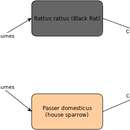Rattus is a genus of muroid rodents, all typically called rats. However, the term rat can also be applied to rodent species outside of this genus.
Species and description
The best-known Rattus species are the black rat (R. rattus) and the brown rat (R. norvegicus). The group is generally known as the Old World rats or true rats and originated in Asia. Rats are bigger than most Old World mice, which are their relatives, but seldom weigh over 500 grams (1.1 lb) in the wild.
Taxonomy of Rattus
The genus Rattus is a member of the giant subfamily Murinae. Several other murine genera are sometimes considered part of Rattus: Lenothrix, Anonymomys, Sundamys, Kadarsanomys, Diplothrix, Margaretamys, Lenomys, Komodomys, Palawanomys, Bunomys, Nesoromys, Stenomys, Taeromys, Paruromys, Abditomys, Tryphomys, Limnomys, Tarsomys, Bullimus, Apomys, Millardia, Srilankamys, Niviventer, Maxomys, Leopoldamys, Berylmys, Mastomys, Myomys, Praomys, Hylomyscus, Heimyscus, Stochomys, Dephomys and Aethomys.
The genus Rattus proper contains 64 extant species. A subgeneric breakdown of the species has been proposed, but does not include all species.[2]
Species
Genus
Rattus – Typical rats
-
incertae sedis
-
Enggano rat (Rattus enganus) – Indonesia (potentially extinct)
-
Philippine forest rat (Rattus everetti) – the Philippines
-
Polynesian rat or kiore (Rattus exulans) – originally native to Bangladesh, Myanmar, Thailand, Cambodia, Laos, Vietnam, Malaysia, and Indonesia, but now introduced throughout the Pacific (including most Polynesian, Melanesian, and Micronesian islands, most notably Fiji, Papua New Guinea, New Zealand, Easter Island and Hawaii), as well as the Philippines, Brunei, and Singapore, origin uncertain in Taiwan
-
Hainald's rat (Rattus hainaldi) – Indonesia
-
Hoogerwerf's rat (Rattus hoogerwerfi) – Indonesia
-
Korinch's rat (Rattus korinchi) – Indonesia
- †Maclear's rat (Rattus macleari) – Christmas Island (now extinct)
-
Nillu rat (Rattus montanus) – Sri Lanka
-
Molaccan prehensile-tailed rat (Rattus morotaiensis) – Indonesia
- †Bulldog rat (Rattus nativitatis) – Christmas Island (now extinct)
-
Kerala rat (Rattus ranjiniae) – India
-
New Ireland forest rat (Rattus sanila) (potentially extinct)
-
Andaman rat (Rattus stoicus) – the Andaman Islands, India
-
Timor rat (Rattus timorensis) – Timor
-
R. norvegicus group
-
Himalayan field rat (Rattus nitidus) – originally native to Bhutan, China, India, Myanmar, Nepal, Thailand, and Vietnam (presence uncertain in Bangladesh), but now introduced to Indonesia, the Philippines, and Palau
-
Brown rat (Rattus norvegicus) – originally native to southeast Siberia, northeast China, and parts of Japan, but now introduced worldwide except Antarctica
-
Turkestan rat (Rattus pyctoris; obs. Rattus turkestanicus) – Afghanistan, China, India, Iran, Kyrgyzstan, Nepal and Pakistan
-
R. rattus group
-
Sunburned rat (Rattus adustus) – Enggano Island, Indonesia
-
Sikkim rat (Rattus andamanensis) – Bhutan, Cambodia, China, India, Laos, Myanmar, Nepal, Thailand and Vietnam
-
Ricefield rat (Rattus argentiventer) – Southeast Asia
-
Summit rat (Rattus baluensis) – Malaysia
-
Aceh rat (Rattus blangorum) – Indonesia
-
Nonsense rat (Rattus burrus) – Nicobar Islands, India
-
Hoffmann's rat (Rattus hoffmanni) – Indonesia
-
Koopman's rat (Rattus koopmani) – Indonesia
-
Lesser ricefield rat (Rattus losea) – China, Laos, Taiwan, Thailand and Vietnam
-
Mentawai rat (Rattus lugens) – Indonesia
-
Mindoro black rat (Rattus mindorensis) – the Philippines
-
Little soft-furred rat (Rattus mollicomulus) – Indonesia
-
Osgood's rat (Rattus osgoodi) – Vietnam
-
Palm rat (Rattus palmarum) – Nicobar Islands, India
-
Black rat (Rattus rattus) – originally native to western India and Pakistan, but now introduced worldwide except Antarctica
-
Little Indochinese field rat (Rattus sakeratensis) – Thailand and Laos
-
Sahyadris forest rat (Rattus satarae) – India
-
Simalur rat (Rattus simalurensis) – Indonesia
-
Tanezumi rat (Rattus tanezumi) – Afghanistan, Bangladesh, Cambodia, China, Cocos (Keeling) Islands, Fiji, India, Indonesia, Japan, North Korea, South Korea, Laos, Malaysia, Myanmar, Nepal, Pakistan, the Philippines, Taiwan, Thailand and Vietnam
-
Tawitawi forest rat (Rattus tawitawiensis) – the Philippines
-
Malayan field rat (Rattus tiomanicus) – Indonesia, Malaysia, the Philippines and Thailand
-
R. xanthurus group
-
R. leucopus group (New Guinean group)
-
R. fuscipes group (Australian group)
Phylogeny
The following phylogeny of selected Rattus species is from Pagès, et al. (2010).[3]
Berylmys bowersi
Berylmys berdmorei
Bandicota savilei
Bandicota indica
Rattus Rattus nitidus
Rattus norvegicus
Rattus exulans
Rattus andamanensis
Rattus argentiventer
Rattus tiomanicus
Rattus losea
Rattus sp.
Rattus tanezumi
Rattus rattus
References
-
^ "Rattus". Integrated Taxonomic Information System. Retrieved 15 November 2021.
-
^ Thomson, Vicki; Wiewel, Andrew; Chinen, Aldo; Maryanto, Ibnu; Sinaga, M. H.; How, Ric; Aplin, Ken; Suzuki, Hitoshi (2018). "A perspective for resolving the systematics of Rattus, the vertebrates with the most influence on human welfare". Zootaxa. 4459 (3): 431–452. doi:10.11646/zootaxa.4459.3.2. PMID 30314119. S2CID 52975664.
-
^ Pagès, Marie; Chaval, Yannick; Herbreteau, Vincent; Waengsothorn, Surachit; Cosson, Jean-François; Hugot, Jean-Pierre; Morand, Serge; Michaux, Johan (2010). "Revisiting the taxonomy of the Rattini tribe: a phylogeny-based delimitation of species boundaries". BMC Evolutionary Biology. 10: 184. doi:10.1186/1471-2148-10-184. PMC 2906473. PMID 20565819.



 Vincent van Gogh (1884)
Vincent van Gogh (1884)